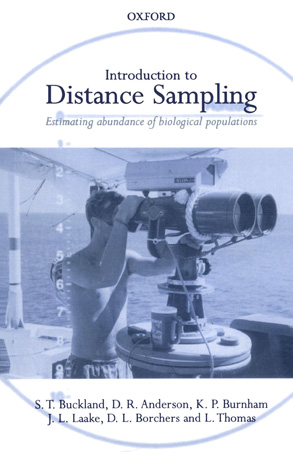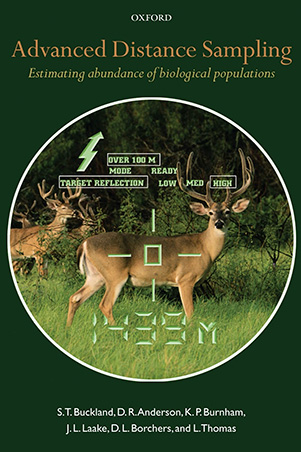Distance sampling methods
What are distance sampling methods?
Distance sampling is a suite of methods for estimating animal density, abundance and distribution from sightings surveys. The surveys are usually conducted by observers on foot or in a vehicle, aircraft or ship, but increasingly, cameras or acoustic recorders are used instead of observers (see for example Buckland et al. J. Appl. Ecol., 2012).
The distance sampling methods developed at CREEM are widely used as a tool by natural resource managers, for monitoring the status of populations of conservation concern, and for routine, often statutory, monitoring of biodiversity. Our Distance Windows software (Thomas et al., 2010) is downloaded on average around 300 times per month. We provide equivalent R packages (Miller et al., J Stat Software, 2019), which are all available at distancesampling.org, and offer a free online workshop to get you started with distance sampling, as well as regular interactive online workshops.
What species are surveyed using these methods?
Distance sampling methods are used to assess a huge variety of species and populations. They are widely used to survey marine mammals (which may require double-observer distance sampling methods), birds (often using point transect methods), terrestrial mammals like elephant (usually using indirect distance sampling methods on elephant dung rather than elephants themselves), antelope of various sorts, and many other species.
Who in CREEM works on these methods?
- Emeritus Prof Steve Buckland
- Prof David Borchers
- Dr Louise Burt
- Dr Danielle Harris
- Emeritus Prof Phil Hammond
- Dr Tiago Marques
- Dr Laura Marshall
- Dr Cornelia Oedekoven
- Dr Charles Paxton
- Dr Eric Rexstad
- Prof Len Thomas
A few relevant publications by CREEM staff
(in addition to the books to the right)
Buckland, S.T., Burt, M.L., Rexstad, E.A., Mellor, M., Williams, A.E. and Woodward, R. 2012. Aerial surveys of seabirds: the advent of digital methods. Journal of Applied Ecology 49: 960-967.
Burt, M.L., Borchers, D.L., Jenkins, K.J. and Marques, T.A. 2014. Using mark-recapture distance sampling methods on line transect surveys. Methods in Ecology and Evolution 5: 1180-1191.
Howe, E.J., Buckland, S.T., Després-Einspenner, M and Kühl, H.S. 2017. Distance sampling with camera traps. Methods in Ecology and Evolution 8: 1558-1565.
Marques, T. A.; Thomas, L.; Fancy, S. G. & Buckland, S. T. 2007. Improving estimates of bird density using multiple covariate distance sampling. The Auk 124: 1229-1243.
Marques, T.A., Thomas, L., Martin, S., Mellinger, D., Ward, J., Moretti, D., Harris, D.V. and Tyack, P.L. 2013. Estimating animal population density using passive acoustics Biological Reviews of the Cambridge Philosophical Society 88: 287–309.
Miller, D.L., Burt, M.L., Rexstad, E.A. and Thomas, L. 2013. Spatial models for distance sampling data: recent developments and future directions. Methods in Ecology and Evolution 4: 1001-1010.
Miller, D.L., Rexstad. E.A. Thomas, L,, Marshall, L. and Laake, J.L. 2019. Distance Sampling in R. Journal of Statistical Software 89: 1-28.
Thomas, L., Buckland, S.T., Rexstad, E.A., Laake, J.L., Strindberg, S., Hedley, S.L., Bishop, J.R.B., Marques, T.A. and Burnham, K.P. 2010. Distance software: design and analysis of distance sampling surveys for estimating population size. Journal of Applied Ecology 47: 5-14.
Some relevant links
Introductory, advanced, and applications distance sampling books



